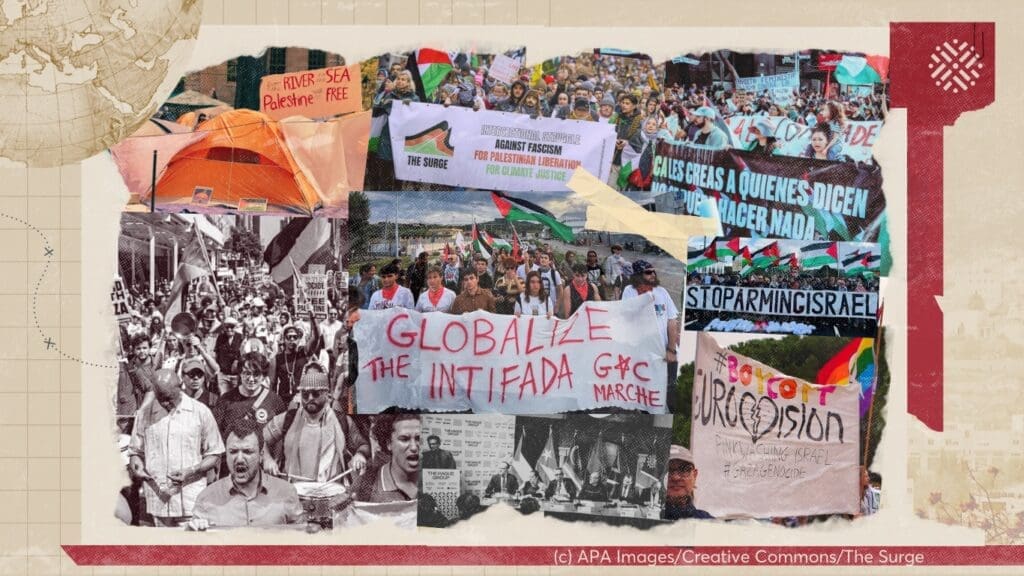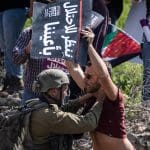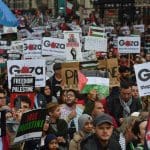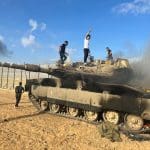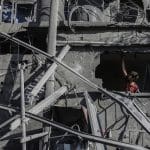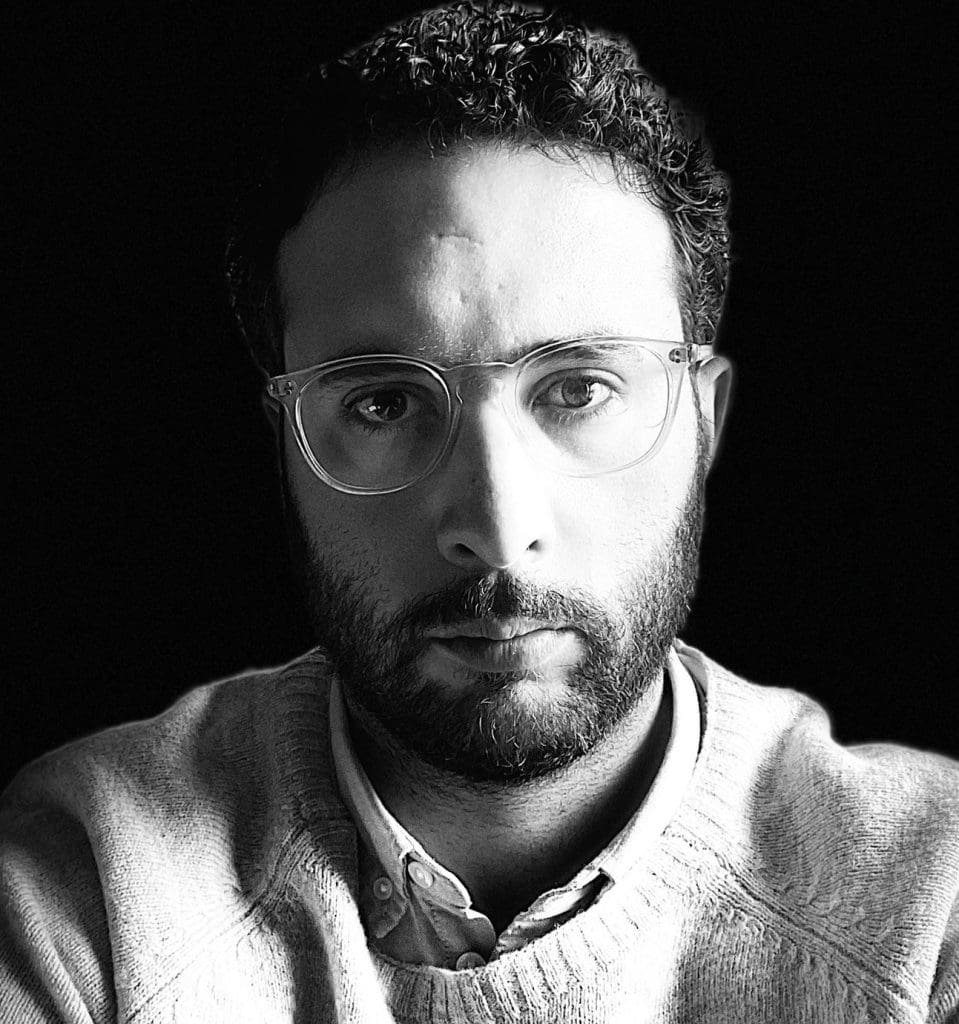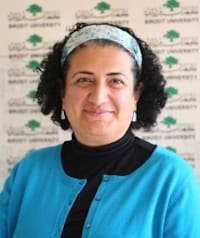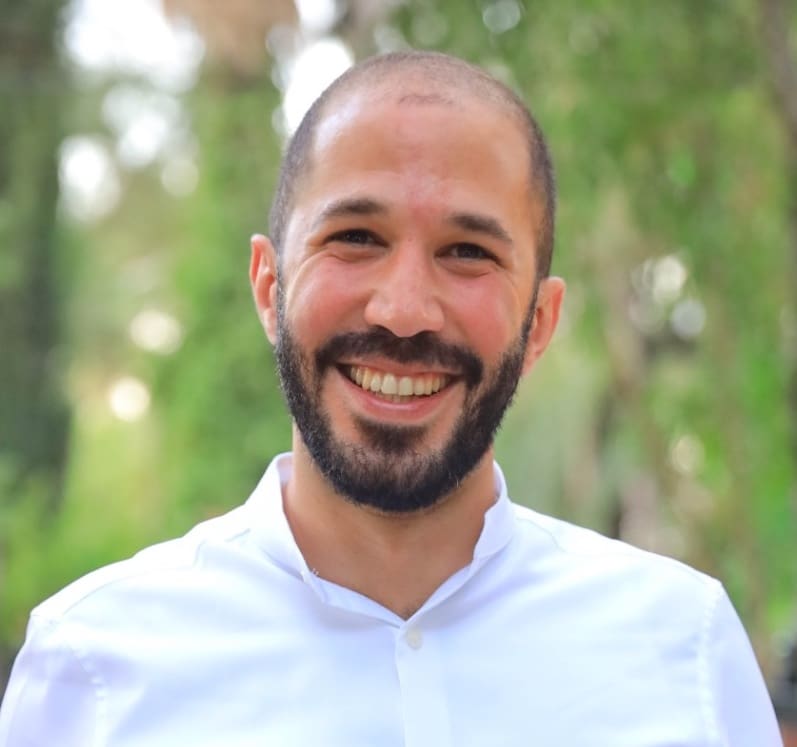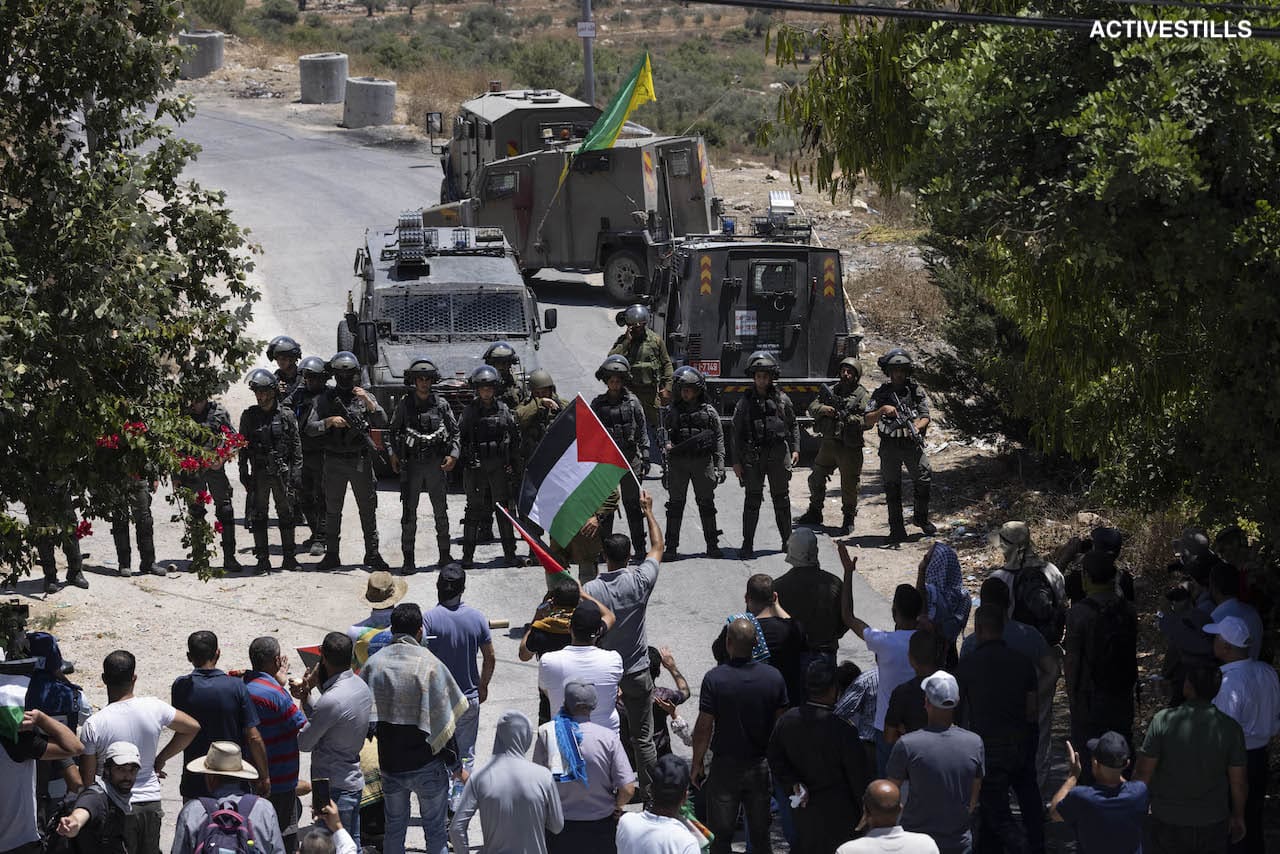
Since the assault on Gaza began in October, 2023, tens of thousands of Palestinians have been killed, injured, or missing, likely buried under the rubble of their homes or shelters. Nearly two million Palestinians in Gaza have been displaced, with cold, thirst, and hunger ravaging the entire population. While the world deliberates on the technicalities of genocide, Israeli colonization of the West Bank and disruption to Palestinian life there has only accelerated.
In this roundtable, Fathi Nimer, Abdaljawad Omar, Basil Farraj, and Samia Botmeh discuss the situation in the West Bank since October 7th 2023. Parallel to the Israeli regime’s genocide campaign on Gaza, the authors delve into the false dichotomy between settler and state, the passivity of the Palestinian Authority (PA), the individual and collective imprisonment of Palestinians, and the dire state of the West Bank economy.
Settlers and the State: Pieces of the Same Puzzle
Fathi Nimer
Concurrent to the Israeli army’s ongoing genocide in Gaza, Israeli settlers have increasingly rampaged across the West Bank. Widespread calls for revenge and collective punishment have fueled campaigns of terror against Palestinian communities, resulting in the forced displacement of nearly 1,000 residents from 13 villages in the first four weeks alone following October 7th, 2023. Between October 7th and December 14th, 2023, West Bank settlers likewise killed 11 Palestinians, including 3 children, and injured an additional 83.
It is farcical to suggest a distinction between settler and state violence: They are part of the same settler-colonial structure, and not only complement each other but depend on one another Share on X
Whenever Israeli settlers reign terror in the West Bank, mainstream media insists on drawing a false distinction between the violent groups and the Israeli army, suggesting the latter has simply lost control or is powerless to stop the attacks. This narrative was peddled in the aftermath of the February 2023 Huwara pogrom, and is similarly being employed today. Such a framing denies a fundamental truth of the dynamics at play in the West Bank, and stems from an erroneous assumption that the Israeli army’s mission is at odds with that of Israeli settlers. In reality, the Israeli military has been explicitly tasked with carrying out the state’s goals of supporting the settlement project and facilitating the transfer of the Palestinian population since 1967. In this regard, Israeli settlers in the West Bank are ideological foot soldiers: their aims are those of the Israeli regime, and vice-versa.
We cannot speak about the settler movement as separate from larger state-backed colonization projects, such as the Allon plan, the guidelines of which animate much of the Israeli regime’s settlement activity to this day. Hence, settler outposts and colonies do not spontaneously sprout from the ground; rather, they result from deliberate policy choices. Most settlements are designated as national priority areas, entitling their residents to subsidized housing, education, and other benefits to encourage land grabs. Moreover, when settlers roam Palestinian neighborhoods and burn down their villages, they are protected and escorted by the Israeli Occupation Forces. Should Palestinians dare to defend themselves, the army springs into action to beat, detain, and even kill them.
In such a context, it is farcical to suggest a distinction between settler and state violence: They are part of the same settler-colonial structure, and not only complement each other but depend on one another. On the rare occasion when there is friction between settlers and soldiers, such a dynamic emanates from disagreements over the tactics of West Bank colonization, not about the goal itself. Settlers typically encourage a quick and direct takeover of territory, while the army follows the state’s policy of a more methodical approach to maintain plausible deniability in front of its global audience. This can lead to tension, as the settlers view the state as indecisive, while the state views the settlers’ actions as indiscreet.
While some erroneously claim that West Bank settlers represent a “fringe” radical group, they enjoy popular support from vast swaths of the Israeli population. Evidence of this has been seen over multiple elections, as settler leaders have reached the highest echelons of the political establishment and serve as generals and ministers. Parties declaring that they exist to serve and expand the West Bank settlement movement now form an integral part of the governing coalition. Such progress has granted the settlers further impunity and privileges—indeed, they have been armed with over 150,000 assault rifles since the beginning of the genocidal incursion into Gaza on October 7th.
In light of the Biden administration’s unwillingness to exert pressure on Israel to cease its bloody assault on Gaza—and the resulting drop in Biden’s approval ratings—the White House scrambled to announce a visa ban on “extremist settlers” in the West Bank as a way to placate its base ahead of the 2024 presidential elections. Such measures target “dozens” of settlers and are designed primarily to give the illusion that the US is taking tangible action to protect Palestinians. The performative nature of this action becomes especially clear when considering that over 160,000 settlers in the West Bank are US citizens and would remain unaffected by such a ban. These US squatters and their supporters have been widely-documented as some of the most belligerent groups responsible for taking over Palestinian homes.
Of course, the distinction made by the international community between West Bank settlements and those elsewhere across colonized Palestine is inaccurate to begin with. All Israeli communities from the Jordan River to the Mediterranean Sea are built on stolen Palestinian land, and attempts to legitimize those within 1948 territory deny the fundamental settler colonial nature of the Israeli state project. Thus, when we recall that Israelis are settlers by definition, the facade of distinction between settler and state crumbles and we are left with only the glaring reality that the two are one and the same.
The Palestinian Authority’s Gamble of Inaction
Abdaljawad Omar
The Fatah-ruled PA has maintained a consistent strategy of indifference toward the fate of Palestinians in Gaza, as well as those it governs in the West Bank. Rather than forcefully challenge the ongoing genocide, PA representatives have offered only empty rhetoric that absolves them from their responsibility to respond with action. In doing so, the PA’s intent to maintain its existing approach toward the Israeli regime is clear—namely, that it will continue to center security collaboration and containment of collective political action in the West Bank as a means to guarantee that the interests of the political elite remain unimpacted by the genocide unfolding kilometers away.
The PA hopes that its stasis will enable it to reap the benefits of the war without immersing itself in the battle Share on X
To fully grasp the intricate dynamics shaping the PA’s response—or lack thereof—to the ongoing massacre of Palestinians in Gaza, one must delve into the multitude of pressures it faces. Foremost among these is the West Bank settler movement, which now wields significant influence over policymaking in Israeli Prime Minister Benjamin Netanyahu’s coalition government. This movement’s approach seeks to render the PA obsolete by doing away with any notion that it can protect the Palestinians it oversees. Indeed, as mentioned in the aforementioned section, settlers are continuing to seize Palestinian property and kill Palestinians with impunity. To ensure that he can galvanize this large settler base in support of his continued leadership, Netanyahu continues to withhold funds from the PA and insist that it will be absent from any “day after” plan for Gaza following the current ethnic cleansing.
Another pressure can be found from the re-emergence of popular Palestinian resistance to the Israeli colonial project in the West Bank. Recent armed insurrections in the northern regions are indicative of an upending of Fatah’s social base. This politics of unbinding from the PA has slowly proved effective in mustering self-defense zones and challenging both Israeli occupation forces and PA passivity. A new generation of fighters is backed by established political organizations—PFLP, Hamas, and Islamic Jihad—in the effort to create a more organized and sustainable armed resistance movement. This rebellion wouldn’t have been possible without the loss of the PA’s ideological and social hold on the Palestinian people, especially among working-class communities in refugee camps and dense urban spaces in the north. The popularity of these groups and the scope of their resistance activities demonstrates the weakening of PA dominance—a trend that hasn’t gone unnoticed by the Israeli forces, which have responded with repeated military incursions in places such as Jenin, Tulkarem, and Nablus, as well as targeted assassinations of those with purported affiliation.
In addition to internal pressures, the PA has become increasingly isolated on both regional and global stages in recent years. Even the US—a significant supporter of the PA for its role as a native enforcer—has excluded it from various diplomatic maneuverings. One example of this was in the US-brokered Abraham Accords, which completely bypassed the PA and effectively ignored the existence of Palestine. Further proof can be seen as the genocide in Gaza unfolds, as US policymakers signal their desire for a “revitalized” PA—including its leadership, composition, and the alliances that form the PA’s political class. Yet despite their desire for “new blood” in the PA, the US and its allies in the region undoubtedly remain reassured by the current PA’s inaction and steadfastness with its policy of security coordination with the Israeli regime.
Nonetheless, the Al-Aqsa Flood operation has shattered the status quo—not only in Gaza but also in the West Bank. The PA has long anchored itself on pragmatism, which promulgates the notion that avenues for change are limited. Leaders such as Abbas and his close advisors heavily rely on this narrative and often critique Palestinian armed resistance as futile. This approach, however, is increasingly unpopular. Recent polls in the West Bank saw a staggering 60% of respondents supporting the disintegration of the PA and more than 90% demanding the resignation of Abbas.
Amidst these pressures, the PA is biding its time; a relative victory for the Palestinian resistance in Gaza or a wider regional solution may bring it back from the sidelines. Until then, the PA hopes that its stasis will enable it to reap the benefits of the war without immersing itself in the battle.
Fortifying Carcerality in the West Bank
Basil Farraj
Prisons have always been central to the Israeli regime’s geographies of violence and torture. Across the West Bank and Gaza, imprisonment has also evolved into a broader state under which the entire Palestinian population lingers. This has particularly been the case since the start of the genocide in Gaza, as the Israeli military escalates its arrest campaigns against Palestinians and holds entire communities under siege, placing severe restrictions on their movement and daily lives.
The violence and torture practiced inside Israeli prisons mirror the measures put in place to confine and control the Palestinian population across all of colonized Palestine Share on X
The number of Palestinian prisoners has more than doubled over the past four months. According to recent figures, the number of Palestinians from the West Bank, including East Jerusalem, detained by Israeli forces since October 7th has reached 6,500 detainees. This is in addition to dozens arrested from the 1948 territories. Reports and testimonies indicate that Palestinians from Gaza are also being held in extremely harsh conditions and are subjected to new levels of torture. Indeed, prisoners have described the conditions in Israeli prisons as akin to the early years of the occupation of the West Bank and Gaza. This includes numerous measures designed to entirely isolate prisoners, including banning family visitations and restricting lawyer visits. Other measures used by the Israel Prison Service include cutting access to water and electricity, providing inadequate and insufficient food, closing prison canteens, confiscating prisoners’ belongings, and denying medical care, further exacerbating its policy of systematic medical negligence. This brutal campaign of torture and violence against Palestinian prisoners has so far led to the deaths of seven prisoners, in addition to an unknown number—recently revealed—of Palestinians killed at an Israeli military base in southern Palestine.
The abuse of Palestinian political prisoners cannot be separated from the wider treatment of the Palestinian population at the hands of the Israeli regime. Indeed, Palestinians have long drawn parallels between what is commonly referred to as the small prison—i.e. Israeli prisons and detention facilities—and the larger prison, which is Palestine, under Israeli settler colonialism. The violence and torture practiced inside Israeli prisons mirror the measures put in place to confine and control the Palestinian population across all of colonized Palestine.
This dynamic has been acutely felt in the West Bank, where the Israeli army has even further restricted the already controlled movement of Palestinians since the start of its genocide in Gaza. This includes blocking entrances to most Palestinian villages, towns, and cities through cement blocks, military checkpoints, and iron gates. Palestinians across the West Bank have reported spending hours at checkpoints to get to their places of work and schools, and facing assaults and beatings by the Israeli military at the entrances of Palestinian villages and towns. This is in addition to Israel’s banning of access to Jerusalem and the 1948 territories. As a result, the West Bank has, in effect, been cordoned off from the rest of colonized Palestine.
Moreover, the Israeli army continues to invade Palestinian towns and villages on a daily basis, arresting, torturing, and harassing Palestinians and employing a “shoot to kill” policy across the West Bank. These violent practices, including by armed settlers, have resulted in the deaths of over 350 Palestinians since October 7th. Palestinians have similarly been killed, tortured, and abused during and after their arrests by the Israeli military. Thus, similar methods of violence are being employed across the West Bank, both within and outside the confines of Israeli prisons.
These practices are not novel, but rather central to Israel’s settler-colonial project. Still, their intensification over the past months, in addition to rising settler violence and land thefts, is transforming the West Bank into a fragmented collection of prisons, where Israeli mechanisms of control and violence are rampant. The measures taken to change the conditions of captivity inside Israeli prisons are mirrored in the violent practices to transform Palestine’s colonized geographies into localized spaces of confinement. Importantly, the Palestinian notion of the small and large prison is not merely metaphorical but a reality that, unless resisted, will etch itself into a permanent carceral condition.
Gaza Genocide and the West Bank Economy
Samia Botmeh
The Palestinian economy is no stranger to economic devastation. The Israeli regime’s occupation of the West Bank and Gaza in 1967 set in motion a series of policies aimed at ensuring a dependent Palestinian economy. The 1993 Oslo Accords further institutionalized the colonial structures of dependency and decapacitated the Palestinian economy to ensure its continued suppression and reliance on non-endogenous sources for its economic survival. The Israeli regime’s devastation of the Palestinian economy during the second Intifada and repeated wars on Gaza since 2008 have further eroded the economy’s productive base and confiscated necessary resources for its potential development.
While the current state of the Palestinian economy may be exceptionally dire, it must not be mistaken for the product of unavoidable circumstances Share on X
Though the West Bank has escaped bombardment in this latest assault, the Israeli regime has nonetheless targeted the territory with a set of oppressive measures with grave economic repercussions. Such measures have included movement restrictions, delays in processing trade in goods and services, raids and incursions that prevent Palestinians from the 1948 territories from accessing goods markets in the West Bank, as well as the pirating of Palestinian clearance revenues.
Additionally, the Israeli regime has barred thousands of Palestinian workers from accessing their work in the Israeli labor market, resulting in increased unemployment and higher competition for jobs in the West Bank. According to the Palestinian Central Bureau of Statistics (PCBS) and International Labor Organization (ILO), unemployment across the West Bank and Gaza more than doubled in the fourth quarter of 2023, reaching an estimated 29% in the West Bank since the genocidal assault on Gaza began. At the same time, daily wages in the West Bank have declined due to the overwhelming availability of workers, creating a market rife with wage exploitation. Daily losses in income total a staggering $12.8 million for workers in the West Bank. Losses in income of this magnitude have resulted in increased poverty rates and inequality across the West Bank and are likely to have devastating consequences beyond the short-term.
The loss of work in the Israeli labor market is not the only reason for the sharp rise in unemployment rates. Restrictions on labor mobility as a result of movement barriers in the West Bank, as mentioned in the previous section, have also affected labor markets. The steep rise of barriers and checkpoints across the West Bank since October 7th has led to significant increases in time and cost of commuting. As a result of being confined to their localities and unable to reach employers in other communities, many workers have had their employment terminated. The PCBS and ILO estimate that in the first two months after the assault on Gaza started, a quarter of a million jobs were lost in the West Bank.
Such movement restrictions and closure of the Israeli market have also affected private sector businesses in the West Bank, in part by raising the costs of acquiring production materials and equipment, which are overwhelmingly sourced from outside the main cities and often from outside of the West Bank. The costs of delivery and shipment, both domestically and internationally, have also risen, thus further reducing profit margins. As a result, preliminary estimates from the PCBS indicate that, during October and November 2023, production in the West Bank decreased by approximately 37%, with an estimated loss of $500 million per month.
Still, while the current state of the Palestinian economy may be exceptionally dire, it must not be mistaken for the product of unavoidable circumstances. Instead, it is the result of functioning under one of the most vicious forms of settler colonization in modern times. Moreover, it is abundantly clear that “recovery models”—pushed by the World Bank and other international institutions—have routinely failed to confront this context and instead focused on ineffective neoliberal policies, further exacerbating Palestinian economic subjugation.
This horrific moment in the Palestinian experience necessitates a rethinking around the political nature of economic recovery. To do so, steps must be taken to end colonial dependency and strengthen the productive base of the Palestinian economy. Such steps include terminating what remains of the forced customs union with Israel, ending policies aimed at pushing people to access bank credit to finance their everyday consumption, investing in local agriculture and manufacturing, and restoring principles of economic solidarity among Palestinians. These initiatives could lay the groundwork for stronger collective resistance against the Zionist settler colonial siege of the Palestinian economy.

